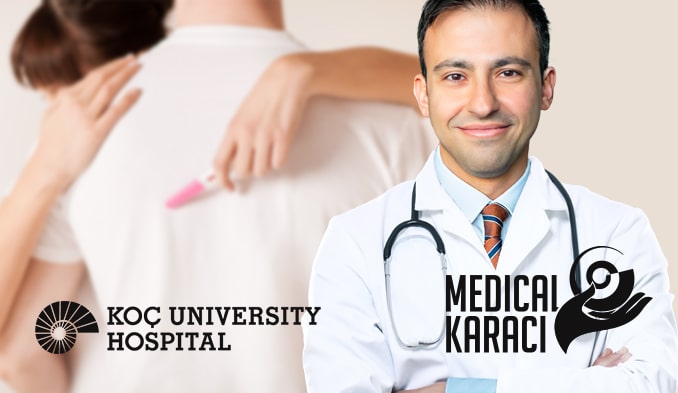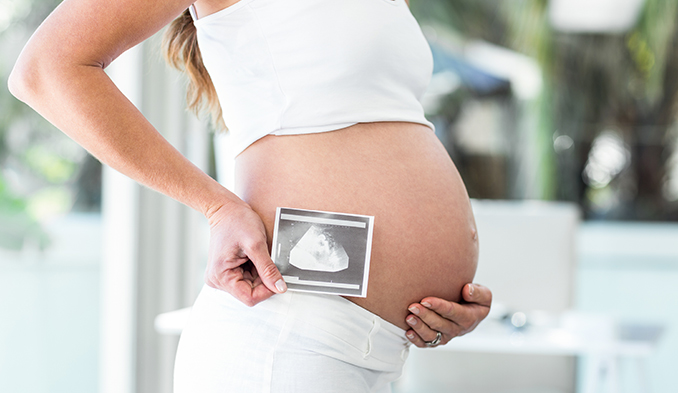Hello, Professor Dr. Bozda-a. Thank you for the opportunity to conduct this interview. We begin this conversation by saying that the topic of infertility is very broad, but we will do our best to answer the most common questions, right?
Professor. Bozdag: Yes, thank you.
Could you explain the definition of infertility and also when is the best time to consult a doctor?
Professor. Bozdag: In short, we can say that if a couple fails to conceive after a year of sexual intercourse, then we can say that the couple suffers from infertility.
But there are actually some risk factors and some determinants that can change this definition. For example, we wait a year for couples when the woman is younger than 35. But if the age is between 35 and 40, then we can only wait six months. And if she is over 40, then we only have to wait a few months.
These are the usual definitions of infertility. But on the other hand, if there are some risk factors, then such a situation should not wait. For example, if a woman has a symptom like oligomenorrhea, which means she has irregular menstrual periods, say she has menstrual bleeding for example every two months rather than every month, then she should not wait for a year. She should see a doctor immediately. On the other hand, if she has undergone any genital surgery, for example, myomectomy, cystectomy or fallopian tube surgery, again she should not wait.
The same applies to the man, if he has any operations on the testicles or if there is a history of genital infections, they should not wait, but should go to the doctor. So, in a nutshell, we can say that they should wait 12 months, but this can change depending on the age of the woman and some risk factors.
Can you tell us more about what are the main stages in infertility research?
Professor. Bozdag: First of all, as I have already mentioned, we are looking at the risk factors. So we need to take a detailed medical history. We need to ask about the couple's obstetric history. If they have had a pregnancy before, then we can wait a little longer before we take further treatment. In addition to the obstetric history, we ask about the regularity of the woman's menstrual cycle. We ask about certain symptoms such as galactorrhoea, which means leakage of fluid from the breast without squeezing, or whether there is excessive hair, say in the chin area, between the breasts or in the area around the navel. These are some symptoms associated with certain endocrinological pathologies.
In addition to the medical history, we actually have two very important tests. One of them is ultrasonography. With ultrasonography, we look to see if there is any abnormality in the uterus. Let's say, for example, there might be some polyp, we can see some fibroids. We also look at the ovaries to see if they have any cysts that might be related to infertility. We also look at the cervix, whether there is a polyp or some other abnormality. So those are the tests for the woman. The ultrasound examination is very important.
On the man's side, we need to do a semen analysis because if we just look at the man externally, we can't tell if he is in normal sexual health or not. So we have to do seminal fluid analysis after two to six days of sexual abstinence. In this way, we monitor the motility and concentration of the spermatozoa, and sometimes we also check their morphology, which can be examined with a microscope. So, seminal fluid analysis and ultrasonography are absolutely mandatory in all couples. In addition, if we can't identify any risk factor or if we can't find any reason for non-pregnancy, then we check the fallopian tubes, because we know that fertilization occurs in the middle of the fallopian tubes.
This is also why pipe health is so important. Unfortunately, however, we can't detect the patterns of the tubes using ultrasonography alone. This is why we administer dye, also called contrast material, from the cervix using a small catheter. The substance itself is not transparent and we simply inject it through the cervix and then look through the upper abdomen using an X-ray. We then see if there is any blockage of the tubes on either side. If everything is fine, it means that there is no aberrant risk factor.
But if a blockage is found, even if only on one side, then we try to conduct treatment, taking into account the other healthy side. So tubal patency should also be checked in couples where there are no aberrant significant factors that may be associated with infertility. That's actually the last study. In addition, laparoscopy or hysteroscopy can be performed, but not in all couples, only in certain cases.
Okay, but what are the indications for in vitro fertilization, known as IVF?
Professor. Bozdag: In fact, in vitro fertilization is a very old procedure. It was first performed in 1978, so it's not that new a technology. There are more than 6 million babies worldwide that have been conceived through IVF technology, so it's not that new, but it's becoming more and more prevalent in our practice. First of all, again, I should say that we do not recommend IVF to all couples.
Sometimes we just wait. We just wait, for example, two more years after a year of failure to get pregnant. Sometimes we just give the patient some pills, for example, in a woman who suffers from polycystic ovary syndrome. But if we can't identify a risk factor, we call it unexplained infertility, and then we usually recommend IVF. Regarding in vitro fertilization, I want to say that technically it's combining an egg and a sperm outside the body. We need both egg and sperm.
First of all, we need to get them outside the body, so if we have to start from the easy steps for the male partner, it is usually not complicated. We simply require an analysis of the man's seminal fluid after sexual abstinence for two to six days. But if he has no visible sperm, then we make a miniature incision in the testicles and try to find out if there are sperm on the small tubes. If we find any, then we use them. This procedure is called testicular sperm extraction, but it is done in men who have no visible sperm on microscopic examination. But in most cases, we just do a small uncomplicated seminal fluid analysis.
On the woman's side, it's a little more complicated because we want more eggs. So to have more eggs, first, we do daily injections of follicle stimulating hormone. It's usually secreted by the brain, but this time we give a little bit more. So 10 to 12 days we do daily injections and during those days we monitor the follicles. We assess whether the eggs are enlarging or not. And after a certain diameter we induce them, induce ovulation and then, under full anesthesia, we collect all the follicles. A long needle is used, but it's generally painless. We do it mostly under full anesthesia. We insert the needle through the vagina and aspirate all the follicles, then send them along with the fluids to the lab.
So actually the critical part is getting into the lab. The quality of the IVF lab depends on the quality of the lab instruments and lab staff as they combine the sperm and eggs. This is called fertilization. And after fertilization, we wait up to five days. We put those eggs, sperm and fertilized eggs into an incubator. The incubator maintains a certain temperature, pH and certain gases. And after five days, we check whether we have a good embryo or not. And after five days, we choose one of them that looks "the most beautiful", and do a transfer. The transfer procedure is very simple. In fact, it is painless. Again, we use a very small catheter and don't have to use general anesthesia. We just insert a small catheter and push it with a gentle movement. We then wait up to 10 days to do a pregnancy test.
In summary, what is in vitro fertilization and what are the basic steps of this technique?
Professor. Bozdag: Actually, as I already mentioned, the first thing is to get eggs, because as the number of eggs increases, so does the number of embryos. So if we have a higher number of embryos, then we can choose the best one. In fact, we can choose the best one by just looking outside the embryo. So we just look at it. If the cells are good, if the cells look symmetrical, if they are aligned with a good, proper shape, then we say "yes, this is a good embryo that meets the requirements." So that's one of the criteria.
Another criterion may be the verification of the quality of the embryo. Thus, for example, on the fifth day of the embryo, as we mentioned before, it has over 100 cells. So we take a few of them and send them to the Department of Genetics, then we wait two or three weeks to find out which ones are healthy and which ones are not. Then, for example, if we send five samples from five embryos, they give us an answer which one is healthy and which one is not and then we transfer the healthy embryo. This way we can actually increase the chance of getting pregnant. In ordinary in vitro fertilization, the chance of getting pregnant is about 50 %, but this way - by checking the genetic health of the embryo, it goes up to 75 %. So a major factor that determines whether to implant the embryo or not is genetic health, so that's vital. In fact, we usually recommend this technique in women over the age of 35. This is one of the procedures where the best embryo is selected.
Another thing is, as already mentioned, is the choice of sperm. If the man is healthy, then we just take the sperm through with simple masturbation. But if there is no visible sperm, then we have to extract from the testicles because there are some ways through which sperm can still be obtained. So we make a miniature incision, again under general anesthesia, and then we look for ways, anatomical ways, by which we can extract some even immature but motile sperm. Then we take them and insert them into the oocyte. That's why we call it testicular sperm extraction. The chance of finding a sperm is about 50 % with such technology. So these are the basic steps.
Okay, but are all these procedures safe for the mother and baby? Clearly with the man there is no cause for concern, but what about the baby and the woman?
Professor. Bozdag: Yes, you are right. I mean, unfortunately, most of the procedures depend on the woman. That's right, you're absolutely right. But if we have to think about the health of the mother, we have to say that the risk of infection, the risk of haemorrhage is much, much lower and is a real rarity in in vitro procedures. I mean, at the time of egg collection, the risk of bleeding and the risk of infection is less than 1 %. This shows how rare it is. But for the general health of the woman, actually these injections are not that harmful because, these are the hormones that have already been produced by the brain.
There are centers in the brain called the pituitary and hypothalamus, so these hormones are already circulating in the brain. To give an example, for example, in an IVF procedure we give follicle stimulating hormone and the serum concentration reaches, let's say, 25 international units (IU) per litre. But in women, when menopause occurs, the concentration is over 100. So it's very low when compared to physiological levels, and only for 10 to 12 days, and therefore has no long-term effect.
But on the other hand, unfortunately, if a woman fails to get pregnant, either naturally or through in vitro fertilisation, she has a higher risk of breast cancer and ovarian cancer. So sometimes there is speculation that in vitro fertilization causes ovarian cancer or breast cancer, but that is not directly related to the in vitro injections. It is mainly related to the absence of any pregnancy. So we can state that it does not give a long term effect on the mother. Regarding the health of the babies, there may be a higher risk of premature birth. This may be related to the higher dose of hormones that are temporarily administered. We have therefore changed our policy.
Mainly we try to do frozen embryo transfer cycles, not cycles with "fresh" embryos, that is, embryos that have not been frozen. Because in the cycle with fresh embryos, we do daily injections and the hormone increases for 10-12 days, and this can lead to premature birth. But when we freeze embryos and wait for the hormone levels to go down, say after one or two months, then we plan to transfer the embryos that we froze before, then the hormone level goes down, so the risk of preterm birth goes down. And so to reduce the risk of preterm birth, we mostly go for frozen cycle. And again, for the health of babies in their infancy, there's actually no significant difference when you compare babies that are conceived and born naturally to babies born through in vitro fertilization. There is no significant risk to their physical or mental health.
So, to avoid premature birth, as I mentioned, we usually do frozen cycles. So in most cases, there's actually no aberrant risk factor for babies from an in vitro procedure.
Okay, and one more question. Are ovarian reserve tests reliable?
Professor. Bozdag: This is a very good question. In fact, ovarian reserve testing is very widespread. I assume it is in Bulgaria, because it is very widespread in Turkey. There are many tests that can reflect ovarian reserve. Actually ovarian reserve means the accumulation of follicles, small follicles that may or may not be seen with ultrasound. There are many follicles in a woman's ovaries. In normal physiology, the level is highest when the fetus is in the mother's uterus. Around the fifth month of pregnancy the woman has even the highest number of follicles. But after childbirth, it begins to decline. And there are many tests that can be done, such as follicle stimulating hormone testing on the days of menstrual bleeding or other tests such as antimullerian hormone testing, which can be done on any day of the menstrual period.
Another option is to simply examine the follicles in the ovaries using ultrasonography. With ultrasonography, we usually count follicles that are between two and ten millimeters in diameter. So we call them antral follicles, and we most commonly use antral follicles and antinuclear hormone, but be aware that there can be some fluctuation in antinuclear hormone levels and antral follicle counts from day to day and between menstrual cycles. For example, in this cycle I may see a lot of follicles in a patient's ovaries, and in the next two months I may see slightly fewer. Or two months later I might see a little more. This is also true for the antimullerian hormone.
There may be some fluctuation. But if there are any risk factors for reduced ovarian reserve, say if her mother entered menopause before the age of 45, or if the woman has menstrual bleeding lasting less than 25 days, or if she has any disease such as endometriosis, if she has had an ovarian cystectomy, or if she is a habitual smoker, these factors can lead to a risk of reduced ovarian reserve. So in this type of women, we can follow up the ovarian reserve tests and if it decreases beyond a certain threshold, then we can advise them to undergo egg freezing. And the egg freezing procedure is the same as in vitro fertilization. Again, we induce patients for 10-12 days with daily injections.
Again, we observe the same things and again when they get fat, we induce them, and then we collect them again using a transvaginal probe, so the procedure is the same as in vitro fertilization. In fact, maybe in the future they won't need those frozen eggs. But if they get early menopause, then women can go back and use those eggs that were previously frozen. So we give the following example - it's like keeping money in a bank. Maybe you won't need it in the future, maybe your salary will increase so that you don't have to use that money that you keep in the bank. But if in the future you are left without any money, then you can go back and use the money you kept in the bank. Along these lines, egg freezing can be offered to women who have a smaller ovarian reserve than other women.
Thank you so much for your time Professor Dr. Bozda-a, and I hope that we were able to educate our audience with all the knowledge you gave us. I wish you the best of luck and continue to make people's dreams come true.
Thank you very much.
Professor. Bozdag: Thank you.







